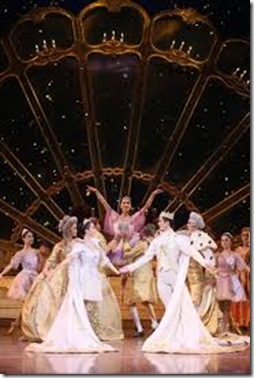The Sleeping Beauty: this dazzling spectacle drizzled in gold is a feast for the eyes.
Photos. Courtesy of the Hong Kong Ballet.
En route to New York City this year, the Hong Kong Ballet’s s dazzling production of The Sleeping Beauty, is currently making a three-day stopover in Ottawa at the the National Arts Centre. Under the keen eye of guest director Cynthia Harvey, former principal dancer of the American Ballet Theatre and whom I saw as guest professor and coach of classical variations at this year’s edition of the Prix de Lausanne in February, the visual interpretation of the Petipa choreography became the focal point of this grandiose performance. Such a wealth of stylistic effects, inspired by the ceremonies that defined the French court of Louis XIV, made an eye-catching show of razzle dazzle with Tchaikovsky’s music under the direction of Judith Yan, Artistic director of the Guelph symphony orchestra. Fabulous wigs, enormous dresses that swung and swooped across the stage, shining satin jackets, glittering chandelier’s, crowds of little nymphs and glowing fairies, dresses of delicately transparent material. Everything was drizzled in gold and covered in sequins. Even when the style changes 100 years later in Acts II and III, the movements of the courtiers as well as the costumes, were adapted to the new time frame and the tastes of the local Hong Kong population.
This production was first of all, a feast for the eyes, a European Fairy tale , as defined by Petipa’s choreography although the ballet was shortened and more bits were added for some of the little groups of dancers who filled the stage with crowds of fairies, nymphs, hunters, little monsters, hunting ladies and numerous young people who came from the Ottawa School of dance. Gone are the romantic forests and the suggestion of a pastoral setting . Even the appearance of the evil Fairy Carabosse danced by a tall, willowy masculine Wei Wei (March 3) who swirls around waving his long arms, twirling his lacy cape and suggesting the appearance of masked demons related to the gallery of figures we see in the Pekin Opera. He is surrounded by his little dancing demons with white skulls for heads and long ratty tails, clinging to the fairy as she predicts the death of the young princess, who will prick her finger on a spindle the day of her 16th Birthday.
Generally speaking, the technique was superb, the points were well formed, the groups of 4 and more carried out their ensemble work with perfect precision, the set changes were done with impeccable efficiency and all went smoothly.
Certain details of the dancing are certainly worth noting . The precise foot-work and perfectly trained limbs at times created a sense that overwhelming attention to technique appeared to dominate the interpretations and dampen at times the fairy- tale lightness of these creatures on stage. Princess Aurore ( principal dancer Yu-Yao Liu) appeared nervous although she was a delightfully fresh and feathery creature who flitted weightlessly through the air. She was however less relaxed than the magnificent Friedemann Vogel, Prince Désiré who awoke her with a kiss and spent the rest of the performance at her side. Vogel is a principal dancer with the Stuttgart Ballet, guest of the Mikhailovsky Theatre, and invited guest of the Hong Kong Ballet. He combined finess, suppleness, grace and an enormous warmth. When Friedemann danced our focus on technique disappeared and all that remained was a sense that his marvellous leaps, his twists and poses flowed easily and naturally from his lythe muscular body. Watching him was the greatest pleasure of the evening. In Act III, (on March 3) one of the jewelled male dancers, decorated in green, accomplished his movements , his leaps and a general control over his whole body that was also quite remarkable but unfortunately his name was not clear. The Lilac Fairy (Ge Gao) also was clearly able to complete her role with grace and precision and was another highlight of the evening.
One moment that evokes great memories is the blue bird duet in Act III. The leaps of the male dancer (Jie Shen) were perfectly formed and the couple created the playful the atmosphere of two little birds flittering around each other, as their feet barely seemed to touch the ground. However, the bluebird was the first time I saw Rudolph Nureyev who happened to be dancing The Sleeping Beautify with the Kirov Ballet in Paris and I will never forget how he literally flew through the air in an apparently effortless performance that brought him thunderous applause and forced him to repeat the moment several times during the show. No dancer since has ever been able to erase that memory. Several days later Nureyev defected to the west and the rest is history.
The Sleeping Beauty by the Hong Kong Ballet continues tonight (March 5) in Southam Hall
The Performance lasts two hours and 30 minutes including two intermissions.
